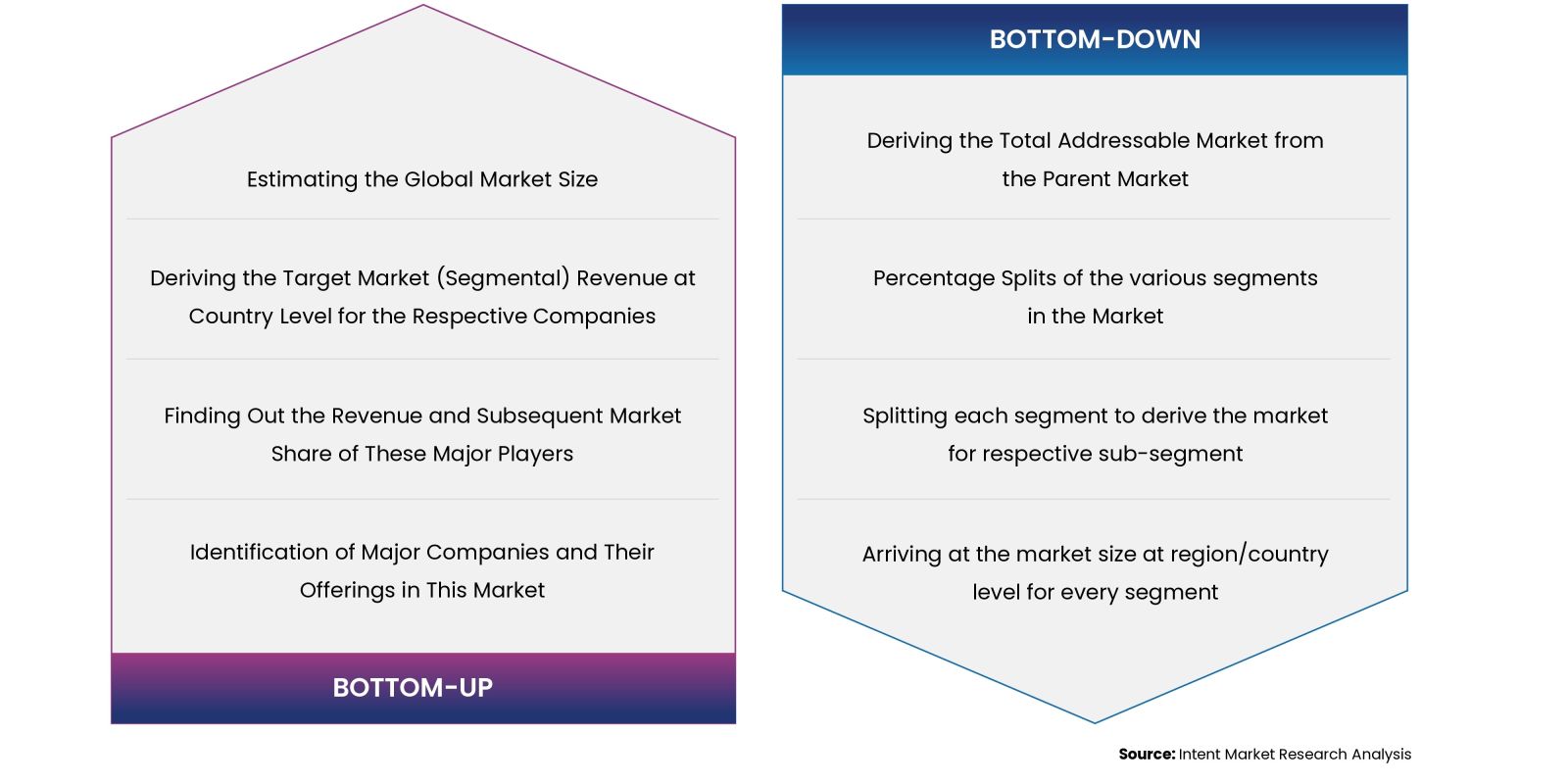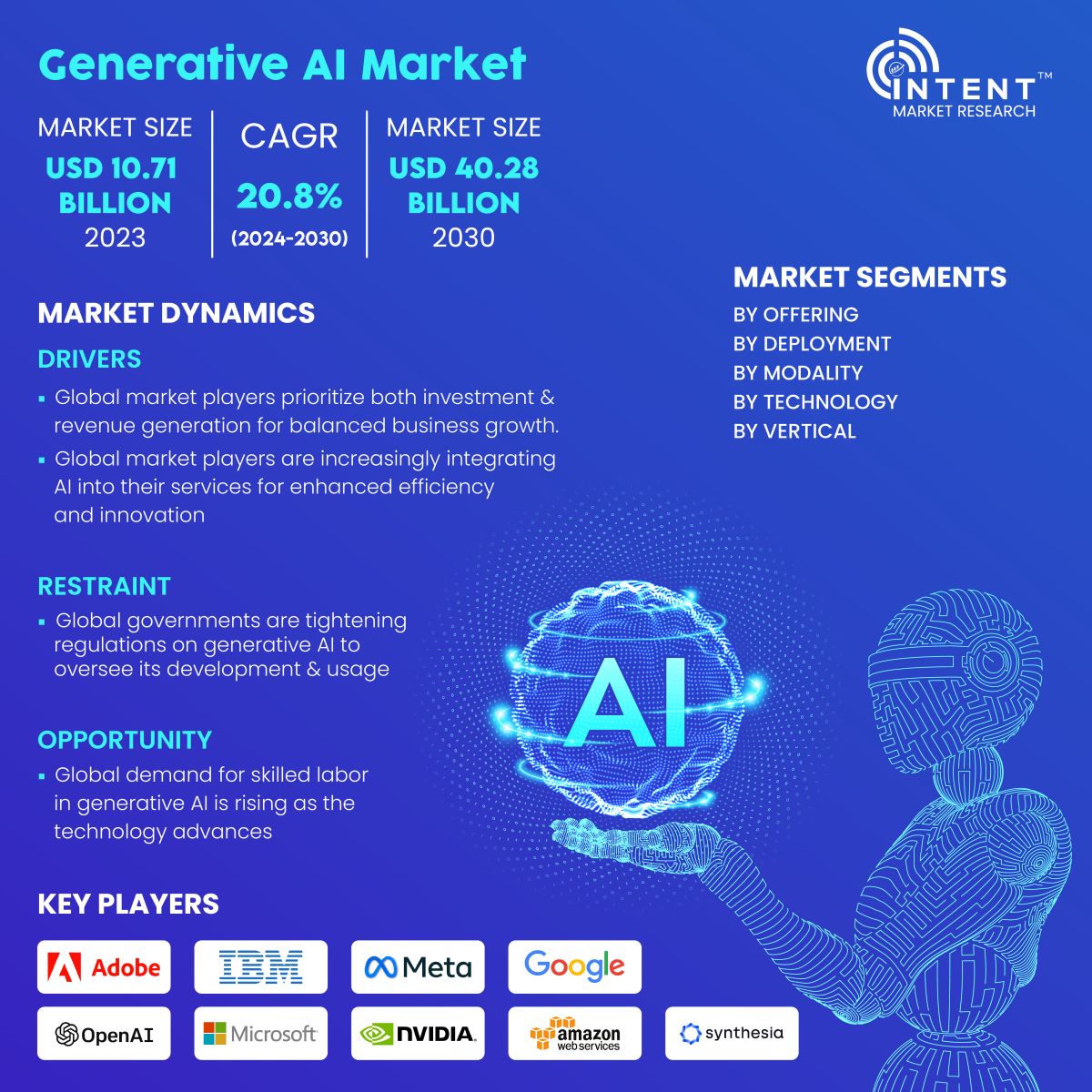According to Intent Market Research, the Generative AI Market is expected to grow from USD 10.71 billion in 2023-e at a CAGR of 20.8% to touch USD 40.28 billion by 2030. Prominent players include Adobe, Amazon Web Services, Alphabet, IBM, Meta, Microsoft, NVIDIA, Synthesia, Inflection AI, Anthropic, OpenAI, and D-ID. The surge in demand for integrating Generative AI associated with every industry is driving the growth of the market.
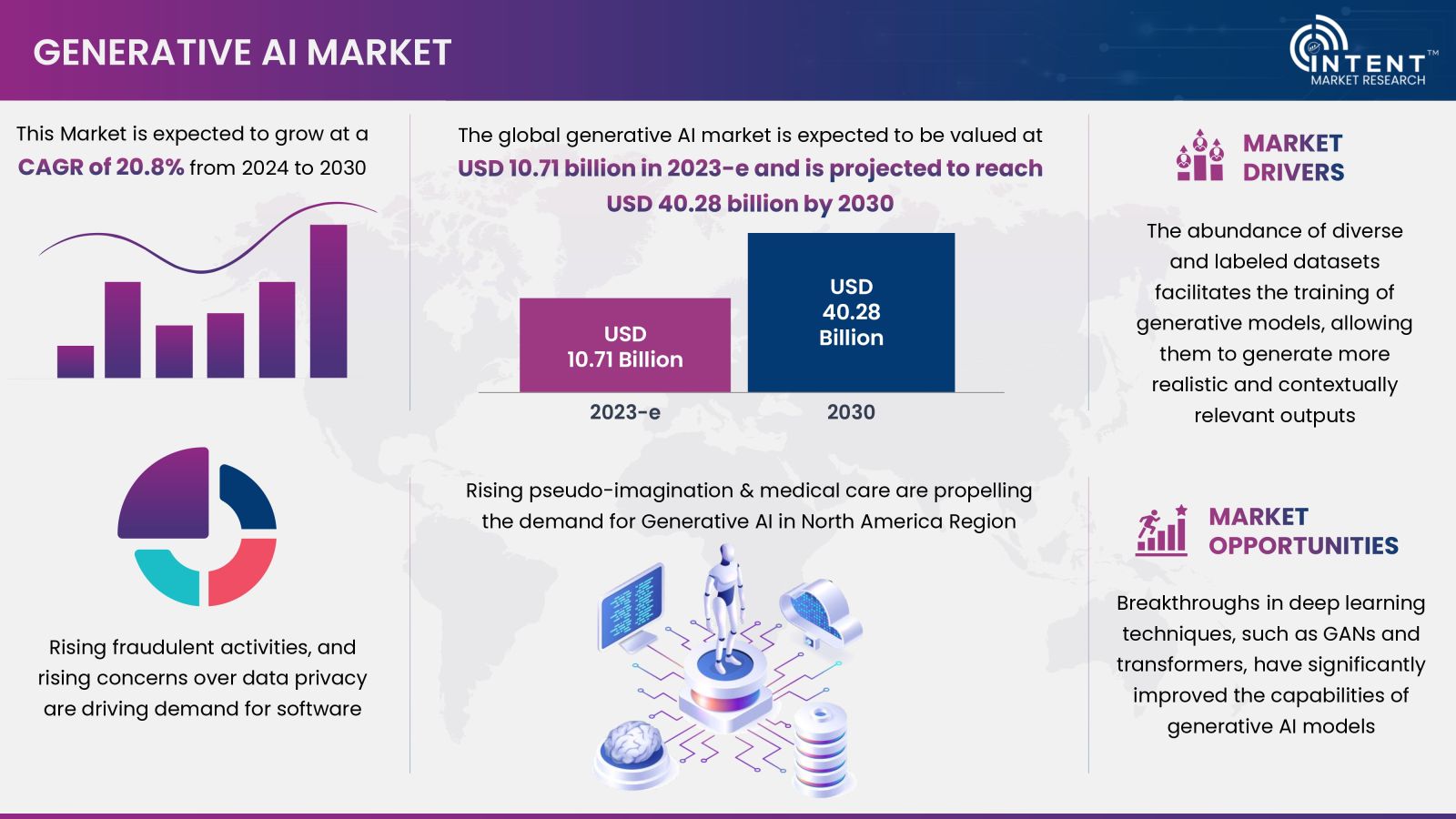
Click here to: Get FREE Sample Pages of this Report
The computational power and the AI platform infrastructure layer started to catch up with the processing demands of generative AI tools. Increasing number of businesses are now able to create generative AI solutions. Major market players such as AWS, Meta, Apple, IBM are into the integration of Gen AI irrespective of the product or business that aims to deliver personalized experiences based on a variety of inputs to their customers and employees. Inputs and outputs to these models can include text, images, sounds, animation, 3D models, or other types of data. Generative AI models use neural networks to identify the patterns and structures within existing data to generate new and original content. One of the breakthroughs with generative AI models is the ability to leverage different learning approaches, including unsupervised or semi-supervised learning for training. This has given organizations the ability to more easily and quickly leverage a large amount of unlabeled data to create foundation models. As the name suggests, foundation models can be used as a base for AI systems that can perform multiple tasks.
Generative AI Market Dynamics
Rising Adoption of Generative AI for Business & Product Development is Fostering the Market Growth
Artificial intelligence is revolutionizing a number of sectors, and it's widely used for tasks like process automation and fraud detection. However, due to the developments in natural language processing and the building of extensive language models, the emphasis has turned to generative AI. In less than a year, generative AI has grown remarkably, quickly transitioning from a consumer phenomenon to being popular in the business space.
The market is expected to grow rapidly over the forecast period due to the increasing use of generative AI in healthcare, defense, gaming, information technology (IT), and agriculture industries.
Generative AI Market Segment Insights
Software Integrating Generative AI is Fostering Market Growth
Based on offering, the software segment is expected to witness significant growth during the forecast period. Generative AI is being integrated into software to provide the best solution for complex problems and improve the user experience. Software efficiency is significantly enhanced with the use of generative AI algorithms. These algorithms can analyze large amounts of data and generate accurate predictions or solutions. By leveraging generative AI, the software can automate tasks, reduce human error, and streamline processes, ultimately leading to improved productivity and overall user satisfaction.
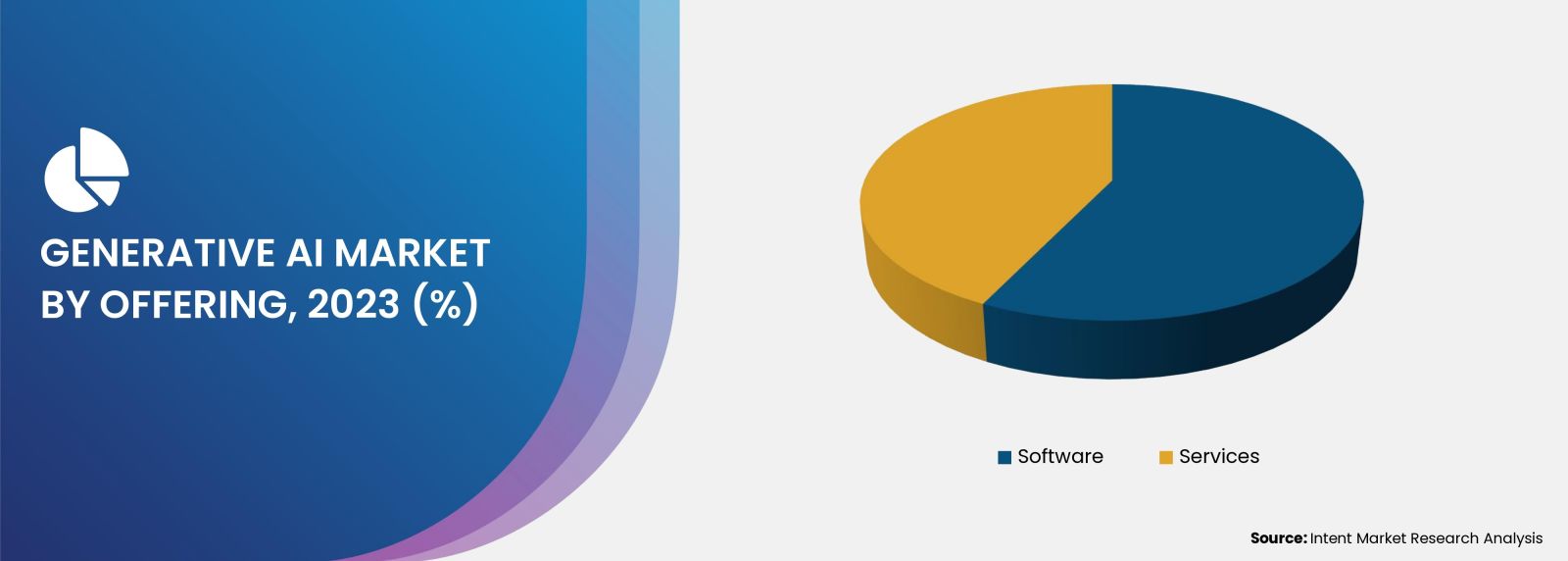
Increasing Collaboration and Acquisition to Provide Cloud-Based Service is Driving the Growth of Generative AI Market
Gen AI has been increasingly deployed cloud-based during the forecast period. The rapid growth of this segment is mainly attributed to high investment in cloud-based services than on-premises solutions. Most of the companies are involved in providing generative AI solutions via cloud-based services. The benefit of cloud-based services is the ability to access and utilize AI capabilities without the need for extensive hardware or software investments. This allows companies to save costs and resources while still benefiting from advanced AI technologies. Additionally, cloud-based services offer scalability, allowing businesses to easily adjust their AI capabilities based on their needs and growth.
Leading IT Companies Are Using Gen AI to Generate Code for the Programmer Thereby Strengthening the Market Growth
Based on modality, the code segment is expected to grow at the highest CAGR during the forecast period. The big giants and leading companies are working on generative AI, which can provide and solve code for the programmer without the need for manual coding. This technology has the potential to revolutionize the way software is developed and significantly speed up the coding process. By leveraging machine learning algorithms, generative AI can analyze vast amounts of code and generate accurate solutions, reducing human effort and increasing productivity in the programming industry.
Regional Insights
Integration of Generative AI in Europe for Banking Service is Driving the Demand for Generative AI
The emergence of artificial intelligence (AI) and generative AI (GenAI) technologies is changing opportunity, value generation, and the future of work throughout the banking sector, after more than three decades of significant digital reforms throughout European institutions. AI is a major topic on everyone's agenda, including those related to opportunities, risks, customers, laws, regulations, and compliance. Banking executives are actively looking for ways to increase efficiency because they understand how GenAI's large language models (LLMs) can change everything from internal operations to customer service and support.
Competitive Landscape
Rising Investment by the Key Players for Business expansion is driving the Generative AI Market
Increasing advancement and adoption of generative AI by industries is expected to drive demand for new skilled people with knowledge, and also the hardware to run the programs. Furthermore, top businesses are spending more on R&D in order to create specialized solutions and improve their position in the market. Some of the companies operating in this market include Adobe, Amazon Web Services, Anthropic, Baidu, Cisco Systems, D-ID, Genie AI, Alphabet, IBM, Inflection AI, Insilico Medicine, Meta, Micron Technology, Microsoft, NVIDIA, OpenAI, Salesforce, and SAP.
Click here to: Get your custom research report today
Generative AI Market Coverage
The report provides key insights into the generative AI market, and it focuses on technological developments, trends, and initiatives taken by the government. In this sector, the analysis delves into market drivers, restraints, opportunities, and other pertinent factors. The report also scrutinizes key players and the competitive landscape in the generative AI market.
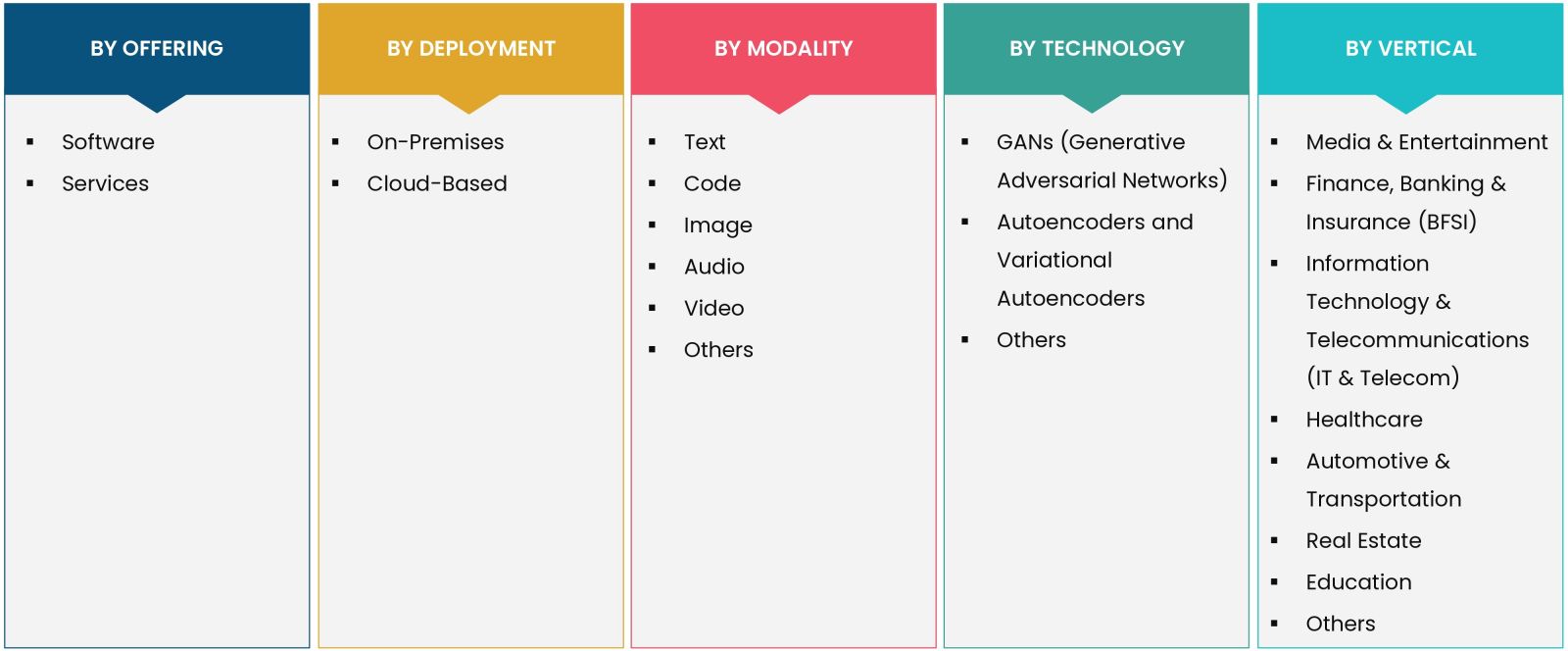
Report Scope
|
Report Features |
Description |
|
Market Value (2023-e) |
USD 10.71 billion |
|
Forecast Revenue (2030) |
USD 40.28 billion |
|
CAGR (2024-2030) |
20.8% |
|
Base Year for Estimation |
2023-e |
|
Historical Period |
2022 |
|
Forecast Period |
2024-2030 |
|
Report Coverage |
Revenue Forecast, Market Dynamics, Competitive Landscape, Recent Developments |
|
Segments Covered |
By Offering (Software, Services), By Deployment (On-Premises, Cloud-Based), By Modality (Text, Code, Image, Audio, Video), By Technology (Generative Adversarial Networks, Autoencoders and Variational Autoencoders), By Vertical (Media & Entertainment, Finance, Banking & Insurance (BFSI), Information Technology & Telecommunications (IT & Telecom), Healthcare, Automotive & Transportation, Real Estate, Education) |
|
Regional Analysis |
North America (US, Canada), Europe (Germany, France, UK, Italy and Rest of Europe), Asia-Pacific (China, Japan, South Korea, India, and rest of Asia-Pacific), Latin America (Brazil, Mexico, Argentina, and Rest of Latin America), Middle East and Africa (Saudi Arabia, South Africa, United Arab Emirates, and Rest of MEA) |
|
Competitive Landscape |
Adobe, AMD, Amazon Web Services, Anthropic, Baidu, Cisco Systems, D-ID, Genie AI, Alphabet, IBM, Inflection AI, Insilico Medicine, Jasper AI, Meta, Micron Technology, Microsoft, MOSTLY AI, NVIDIA, OpenAI, Salesforce, SAP, SoundHound AI, Synthesia, Unity Technologies |
|
Customization Scope |
Customization for segments, region/country-level will be provided. Moreover, additional customization can be done based on the requirements. |
|
Purchase Options |
We have three licenses to opt for Single User License, Multi-User License (Up to 5 Users), Corporate Use License (Unlimited User and Printable PDF) |
|
1.Introduction |
|
1.1.Key Research Objectives |
|
1.2.Market Definition |
|
1.3.Report Scope |
|
1.4.Currency & Conversion |
|
2.Research Methodology |
|
2.1.Research Approach |
|
2.1.1.Top-Down Method |
|
2.1.2.Bottom-Up Method |
|
2.1.3.Factor Impact Analysis |
|
2.2.Insights & Data Collection Process |
|
2.2.1.Secondary Research |
|
2.2.2.Primary Research |
|
2.3.Data Mining Process |
|
2.3.1.Data Analysis |
|
2.3.2.Data Validation and Revalidation |
|
2.3.3.Data Triangulation |
|
3.Executive Summary |
|
4.Premium Insights |
|
4.1.Regulatory Framework |
|
4.1.1.United States |
|
4.1.2.European Union |
|
4.1.3.United Kingdom |
|
4.1.4.China |
|
4.2.Use Case Analysis |
|
4.2.1.Use of Generative AI: Nike and Personalized Product Design |
|
4.2.2.Insilco Medicine: Designing Drugs with the Power of Generative AI |
|
4.2.3.Amazon AWS: Building a Generative AI Powerhouse in the Cloud |
|
4.2.4.Salesforce: Boosting Sales and Marketing with Generative AI |
|
4.3.Emerging Trends in Generative AI Market |
|
4.3.1.Technological Advances and Future Opportunity Analysis |
|
4.3.2.Roadmap & Shifts of Generative AI Market |
|
4.4. Competitive Matrix Across Different Verticals |
|
4.5. Competitive Benchmarking Across Different Modalities |
|
4.6.Patent Overview |
|
5.Generative AI Market, by Offering (Market Size & Forecast: USD Billion, 2024 – 2030) |
|
5.1.Introduction |
|
5.2.Solutions |
|
5.3.Services |
|
5.3.1.Subscription-Based Services |
|
5.3.2.One-Time Payment Services |
|
5.3.3.Value-Based Pricing Services |
|
6.Generative AI Market, by Deployment (Market Size & Forecast: USD Billion, 2024 – 2030) |
|
6.1.On-premises |
|
6.2.Cloud-based |
|
7.Generative AI Market, by Modality (Market Size & Forecast: USD Billion, 2024 – 2030) |
|
7.1.Introduction |
|
7.2.Text |
|
7.3.Code |
|
7.4.Image |
|
7.5.Audio |
|
7.6.Video |
|
7.7.Others |
|
8.Generative AI Market, by Technology (Market Size & Forecast: USD Billion, 2024 – 2030) |
|
8.1.Introduction |
|
8.2.GANs (Generative Adversarial Networks) |
|
8.3.Autoencoders and Variational Autoencoders |
|
8.4.Others |
|
9.Generative AI Market, by Vertical (Market Size & Forecast: USD Billion, 2024 – 2030) |
|
9.1.Introduction |
|
9.2.Media & Entertainment |
|
9.2.1.Content Creation |
|
9.2.2.Marketing & Advertising |
|
9.2.3.Gaming & VR |
|
9.3.Banking, Financial Services and Insurance (BFSI) |
|
9.3.1.Fraud Detection & Risk Management |
|
9.3.2.Personalized Finance, Customer Service & Marketing |
|
9.4. Information Technology & Telecommunications (IT & Telecom) |
|
9.4.1.Solution Development |
|
9.4.2.Network Optimization & Security |
|
9.4.1.Customer Support & Engagement |
|
9.5.Healthcare |
|
9.5.1.Medical Image Analysis & Diagnosis |
|
9.5.2.Drug Discovery & Development |
|
9.5.3.Medical Research & Education |
|
9.6.Automotive & Transportation |
|
9.6.1.Self-Driving Car Development |
|
9.6.2.Traffic Management & Optimization |
|
9.6.3.Vehicle Design & Manufacturing |
|
9.7.Real Estate |
|
9.7.1.Architectural Design and Planning |
|
9.7.2.Property Valuation and Investment |
|
9.7.3.Virtual Property Tours and Visualization |
|
9.7.4.Space Planning and Interior Design |
|
9.7.5.Property Management and Maintenance |
|
9.8.Education |
|
9.9.Others |
|
10.Regional Analysis (Market Size & Forecast: USD Billion, 2024 – 2030) |
|
10.1.Regional Overview |
|
10.2.North America |
|
10.2.1.Regional Trends & Growth Drivers |
|
10.2.1.1.Market Players Focusing On Investment But Also On Revenue Generation |
|
10.2.1.2.Increase In Integration Of AI By North American Market Players |
|
10.2.2.Barriers & Challenges |
|
10.2.2.1.Government Regulations On Generative AI |
|
10.2.2.2.Rising Concerns About Data Security By Governments |
|
10.2.3.Opportunities |
|
10.2.3.1.Rising Demand For Skilled Labor For Generative AI |
|
10.2.3.2.Rise In Government Funding For The New Start-ups For Generative AI |
|
10.2.4.North America Generative AI Market, by Offering |
|
10.2.5.North America Generative AI Market, by Deployment |
|
10.2.6.North America Generative AI Market, by Modality |
|
10.2.7.North America Generative AI Market, by Technology |
|
10.2.8.North America Generative AI Market, by Vertical |
|
*Similar segmentation will be provided at each regional level |
|
10.3.By Country |
|
10.3.1.US |
|
10.3.1.1.US Generative AI Market, by Offering |
|
10.3.1.2.US Generative AI Market, by Deployment |
|
10.3.1.3.US Generative AI Market, by Modality |
|
10.3.1.4.US Generative AI Market, by Technology |
|
10.3.1.5.US Generative AI Market, by Vertical |
|
10.3.2.Canada |
|
*Similar segmentation will be provided at each country level |
|
10.4.Europe |
|
10.4.1.United Kingdom |
|
10.4.2.Germany |
|
10.4.3.France |
|
10.4.4.Italy |
|
10.4.5.Rest of Europe |
|
10.5.APAC |
|
10.5.1.China |
|
10.5.2.India |
|
10.5.3.South Korea |
|
10.5.4.Rest of Asia Pacific |
|
10.6.Latin America |
|
10.6.1.Brazil |
|
10.6.2.Mexico |
|
10.6.3.Argentina |
|
10.6.4.Rest of Latin America |
|
10.7.Middle East & Africa |
|
10.7.1.United Arab Emirates |
|
10.7.2.Saudi Arabia |
|
10.7.3.South Africa |
|
10.7.4.Rest of Middle East & Africa |
|
11.Competitive Landscape |
|
11.1.Introduction |
|
11.2.Competitive Matrix |
|
11.3.Key Strategic Development |
|
11.3.1.Overview |
|
11.3.2.Acquisition |
|
11.3.3.Business Expansion |
|
11.3.4.Collaboration & Their Expansion |
|
11.3.5.Company and Product Expansion & Company Merger |
|
11.3.6.Product launch & innovations |
|
11.3.7.Funding & Investment |
|
11.3.8.Other Development |
|
12.Company Profiles |
|
12.1.Leading Companies |
|
12.1.1.Adobe |
|
12.1.1.1.Company Overview |
|
12.1.1.2.Company Financials |
|
12.1.1.3.Product/Service Portfolio |
|
12.1.1.4.Recent Developments |
|
12.1.1.5.IMR Analysis |
|
*Similar information will be provided for other companies |
|
12.1.2.Alphabet |
|
12.1.3.Amazon Web Services |
|
12.1.4.Anthropic PBC |
|
12.1.5.D-ID |
|
12.1.6.IBM |
|
12.1.7.Inflection AI |
|
12.1.8.Insilico Medicine |
|
12.1.9.Jasper AI |
|
12.1.10.Meta |
|
12.1.11.Microsoft |
|
12.1.12.NVIDIA Corporation |
|
12.1.13.OpenAI |
|
12.1.14.Synthesia Limited |
|
12.1.15.Unity Technologies |
|
12.2.Emerging Companies |
|
12.2.1.Advanced Micro Devices |
|
12.2.1.1.Company Overview |
|
12.2.1.2.Recent Developments |
|
12.2.1.3.IMR Analysis |
|
12.2.2.BAIDU |
|
12.2.3.Cisco Systems |
|
12.2.4.Genie AI |
|
12.2.5.Micron Technology |
|
12.2.6.MOSTLY AI |
|
12.2.7.Salesforce |
|
12.2.8.SAP |
|
12.2.9.Simplified AI |
|
12.2.10.Soundhound AI |
|
13.Appendix |
|
13.1.Discussion Guidelines |
Intent Market Research employs a rigorous methodology to minimize residual errors by carefully defining the scope, validating findings through primary research, and consistently updating our in-house database. This dynamic approach allows us to capture ongoing market fluctuations and adapt to evolving market uncertainties.
The research factors used in our methodology vary depending on the specific market being analyzed. To begin with, we incorporate both demand and supply side information into our model to identify and address market gaps. Additionally, we also employ approaches such as Macro-Indicator Analysis, Factor Analysis, Value Chain-Based Sizing, and forecasting to further increase the accuracy of the numbers and validate the findings.
Research Approach
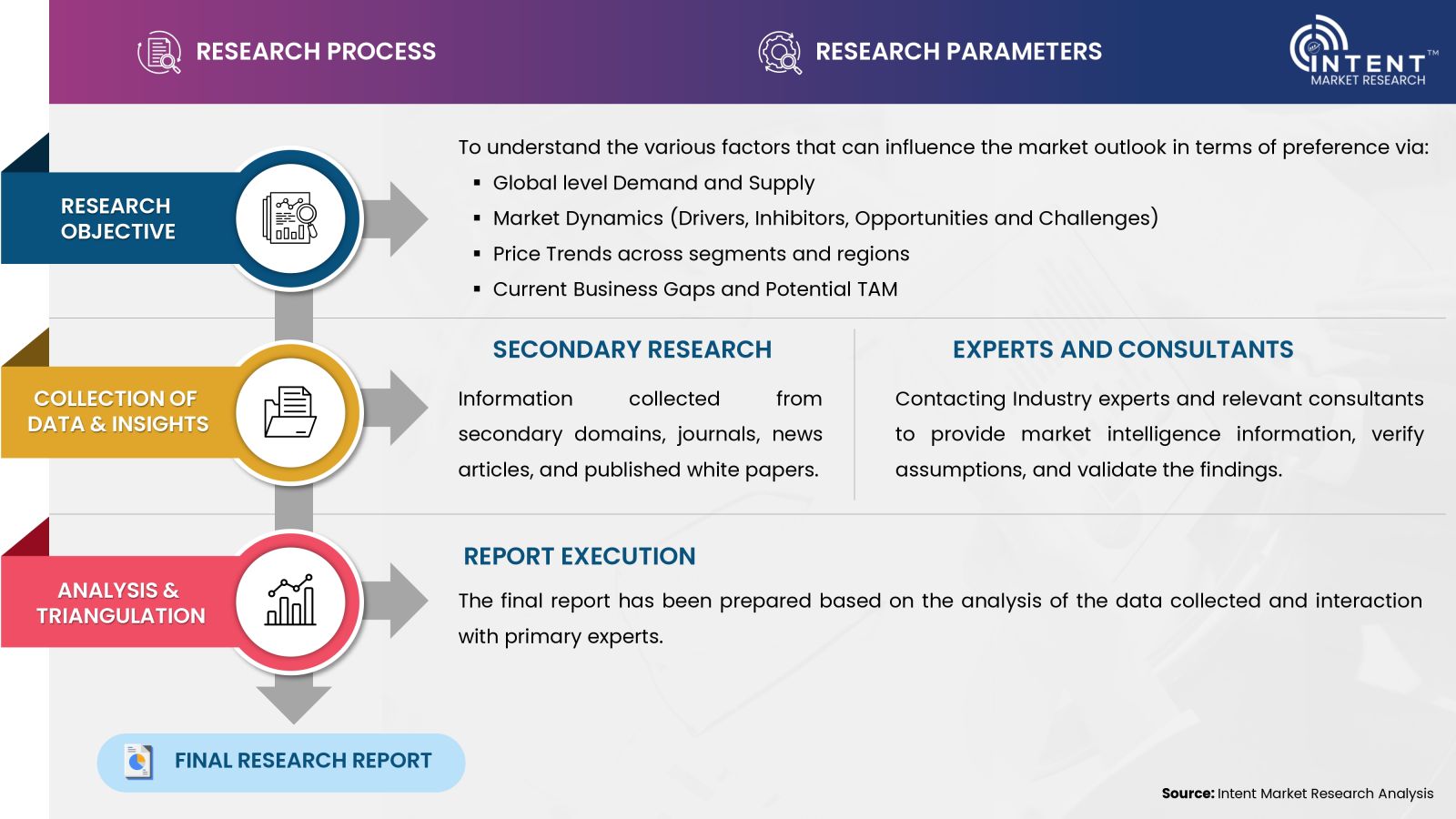
- Secondary Research Approach: During the initial phase of the research process, we acquire and accumulate extensive data continuously. This data is carefully filtered and validated through a variety of secondary sources.
- Primary Research Approach: Following the consolidation of data gathered through secondary research, we initiate a validation process to verify all the market numbers, and assumptions and validate the findings by engaging with subject matter experts.
Data Collection, Analysis and Interpretation:
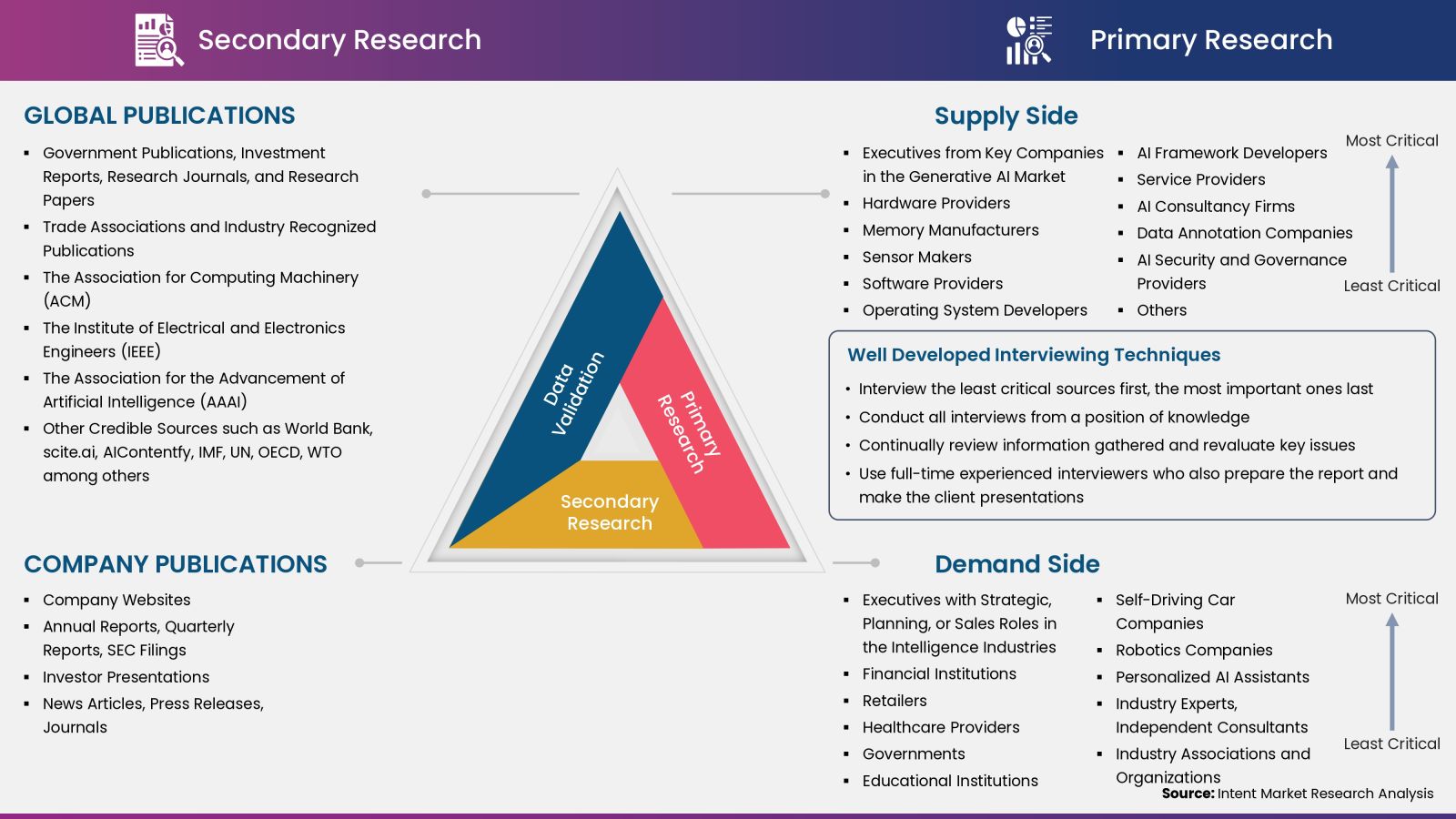
Research Methodology
Our market research methodology utilizes both top-down and bottom-up approaches to segment and estimate quantitative aspects of the market. We also employ multi-perspective analysis, examining the market from distinct viewpoints.
